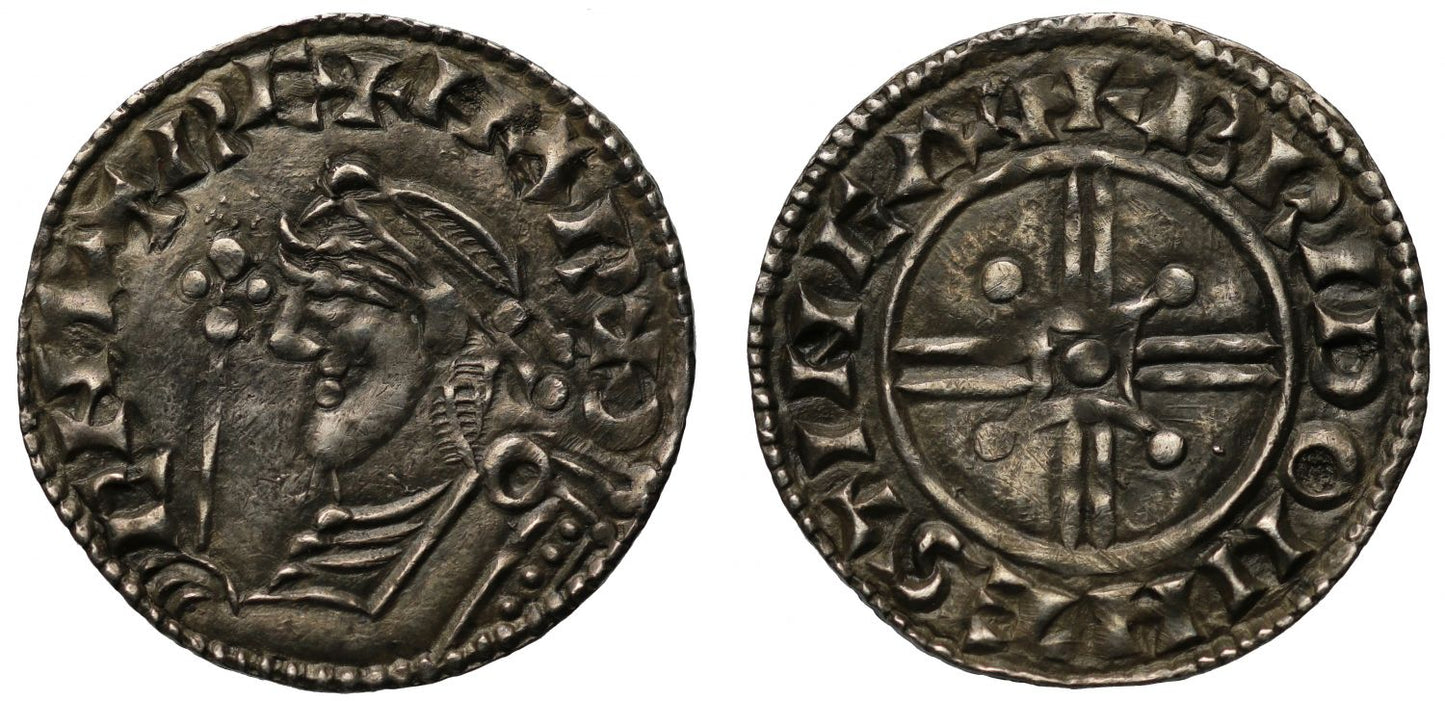FAQs
What makes a coin valuable?
I have coins to sell, what’s the next step?
How will my purchases be shipped?
What happens if I’m not entirely happy with my purchase?
Harthacanute Penny, Arm & Sceptre type, Hastings Mint, Moneyer Brid
Harthacanute (1035-42),silver Penny, arm and sceptre type (1040-42), Hastings Mint, Moneyer Brid, diademed bust left with arm and sceptre, legend commences at top in full name, +HARÐ RNVT RE,revpellet at centre of quadrilateral with pellets on apexes, all over short voided cross which meets inner linear circle, legend and outer beaded border surrounding, +BRID ON HÆSTINGAN, weight 1.12g (SCBI -; cf.Parsons 73-74; BMC type II; N.811; S.1168).Toned well centred, good very fine and rare, especially with such a full mint reading for Hastings.
The legends translate as "Harthacanute King" on obverse and on the reverse "Brid of Hastings."
Of the 230 reverse legend readings H. A. Parsons records in his article "The Anglo-Saxon Coins of Harthacnut" British Numismatic Journal volume 11, 1915, only two are for Brid at Hastings and neither show an extended mint name like this piece which was unknown to Parsons. According to North the Hastings Mint operated with only three moneyers in this reign and only for one type which is of jewel cross type, therefore this coin is an addition to North too.
Harthacanute was the only son from the union of Canute and Emma widow of King Aethelred II who had married in 1017 and he was presumably born in 1018. He became nominal ruler of Denmark in 1023 around the age of 5 with Thorkell the Tall as regent, and subsequently absent from England for most of his life. When his Father Canute died in 1035 Harthacanute was 17 years of age but could not leave Denmark for fear of invasion from Norway. In England he had support for Kingship from Godwin of Wessex and his mother Emma in Winchester. Subsequently in 1037 Godwin crossed over to side with Harold, and Emma fled across the channel to Bruges, where Harthacanute eventually joined her with his fleet in late 1039. After agreeing terms with Magnus of Norway on the basis as they were both childless, that whoever passed away first would inherit the other's Kingdom. Subsequently Magnus outlived Harthacanute and would later claim that their regnal agreement included England as well as Denmark. It was at this time that Emma brought her son by Aethelred II Edward, later the Confessor, to meet with Harthacanute. Before the fleet could embark Harold died in March of 1040 avoiding any conflict. Harthacanute was crowned on the 18th June 1040 at Canterbury and named Edward as his heir in 1041. Harthacanute died suddenly on the 8th June 1042 after imbibing too much at a wedding celebration aged circa 24.
The Cinque Port of Hastings on the East Sussex coast is mentioned in the Burghal Hidage and was first overrun by the Danes in 1011. Most famously known for the Battle of Hastings in 1066, William the Conqueror actually landed at Pevensey a few miles down the coast and marched to Hastings where he first built a stockade. The battlefield where he defeated Harold Godwinson is actually just over 5 miles inland at the town of Battle and the stockade was later fortified as a stone built castle. Minting activity occurs from the reign of Aethelred II through to King Stephen.
Provenance:
Ex Classical Numismatic Group webshop, December 2020.
Ex Collection of an English Doctor part II, Sovereign Rarities fixed price list online May 2022.
FAQs
What makes a coin valuable?
I have coins to sell, what’s the next step?
How will my purchases be shipped?
What happens if I’m not entirely happy with my purchase?













